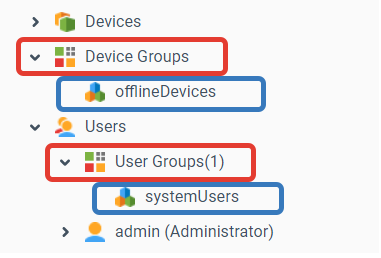Groups
Groups are used to combine devices or any other system resources ( event filters, alerts, etc.) to simplify management of large device/resource sets and make batch operations more convenient. It is easy to execute an operation over all objects in a group, e.g. reboot ten devices at once. Groups also provide an easy way to apply similar settings to all members or automatically replicate configuration changes between them.
 | Related tutorial: Using Resource and Device Templates |
Dynamic Groups
While it's possible to add members to any group using drag and drop, some groups may also auto-populate their contents. Such a dynamic group has a so-called Validity Expression that is used to check whether every system resource is valid for this group. If it is, the resource is automatically added to the group, and it will be auto-removed once it will no longer match the Validity Expression.
Example use case: each device has a Type property, and certain Iotellect distributions include dynamic groups holding devices of particular types, e.g. printers or routers.
Nested Groups
It's possible to put groups into other groups. Group nesting level is not limited.
Group Status
For sets of devices and other "dynamic" resources, groups provide an aggregate status calculation method. For example, a group of devices may get red ("Problem" status) if at least one device in a group has synchronization errors. If no devices have errors, a group will be yellow ("Offline" status) if at least one member is disconnected and green ("Normal" status) otherwise. This is totally flexible.
Master Values
Another feature of groups is integration with the Common Data facility that allows to have "master" values of group member properties. Changes of master value are automatically applied to all group members.
Administering Groups
Two contexts are used to administer groups: one is the general Groups context, which serves as a container for groups of a particular type. The other is the Group context, which represents one group.

Was this page helpful?